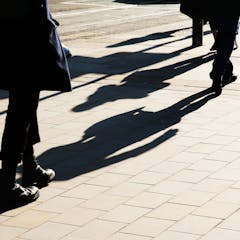
Articles sur Walking
Affichage de 81 à 100 de 128 articles

Trees clean urban air, store carbon, slow floodwaters and can be used to design safer streets. Scholars are starting to calculate what these services are worth – a fitting topic for Arbor Day.

Getting enough exercise to offset the health impacts of sitting might be easier than you think, new research shows.

In many cities, convention holds that there’s a lane for walking and a lane for standing on the escalator. But human systems engineers suggest this isn’t the most efficient option for the system.

Other people influence how we vote, what jobs we apply for, which gadgets we buy – so of course they influence how we get around the city.

Alone and adrift in Melbourne, Cassandra Pybus returned on a whim to her childhood home of Tasmania. There, she rediscovered nature’s power, encountering the island’s difficult history as well as her own.

Many of us are programmed to aim for 10,000 steps a day. This target is not right for everyone – but we can all benefit from setting step goals to increase our activity.

If the menu of potential activities that do us good is made to look uninviting or challenging, we are more likely to choose the easier but less healthy option.

The private car is the default transport option for many families. This reduces physical activity and increases greenhouse gas emissions, with unhealthy results for their children and the environment.

The city where the Kyoto Protocol was signed resolved some years ago to move away from cars and towards low-emission alternatives for getting around. And it’s making real progress towards that goal.

Research published today shows that walking again is possible for individuals with spinal cord injury. After electrical stimulation, three people with lower leg paralysis could walk to some extent.

It can feel much faster to get the bus – but that could all be a matter of perspective.

What’s your risk of dying if you cycle to work, versus the health benefits? What about walking, or driving, or catching a train? Here are the risks and benefits.

Everyone doesn’t simply wait their turn at traffic lights. Signals are set up to enable a ‘green wave’ for cars and adjust to heavy traffic, making walkers wait longer no matter how many there are.

A new study found those who reported walking faster were less likely to die prematurely.

The Daily Mile started in a primary school in central Scotland six years ago. Now it has spread to 3,600 schools in 35 countries.

Four out of five experts say walking is enough exercise.

The relationship between weather and our travel choices is complicated. We can’t change the weather, but, with many other factors in play, good policy and design can reduce its impacts.

New analysis reveals just how little is spent on cycling and walking projects around Australia. No state’s spending on cycling is more than 1.5% of its road funding.

There are many benefits to walking - whether you do it in a group or on your own.

Little skates that ‘walk’ across the ocean floor show how fish brains evolved to pave the way for working legs.
